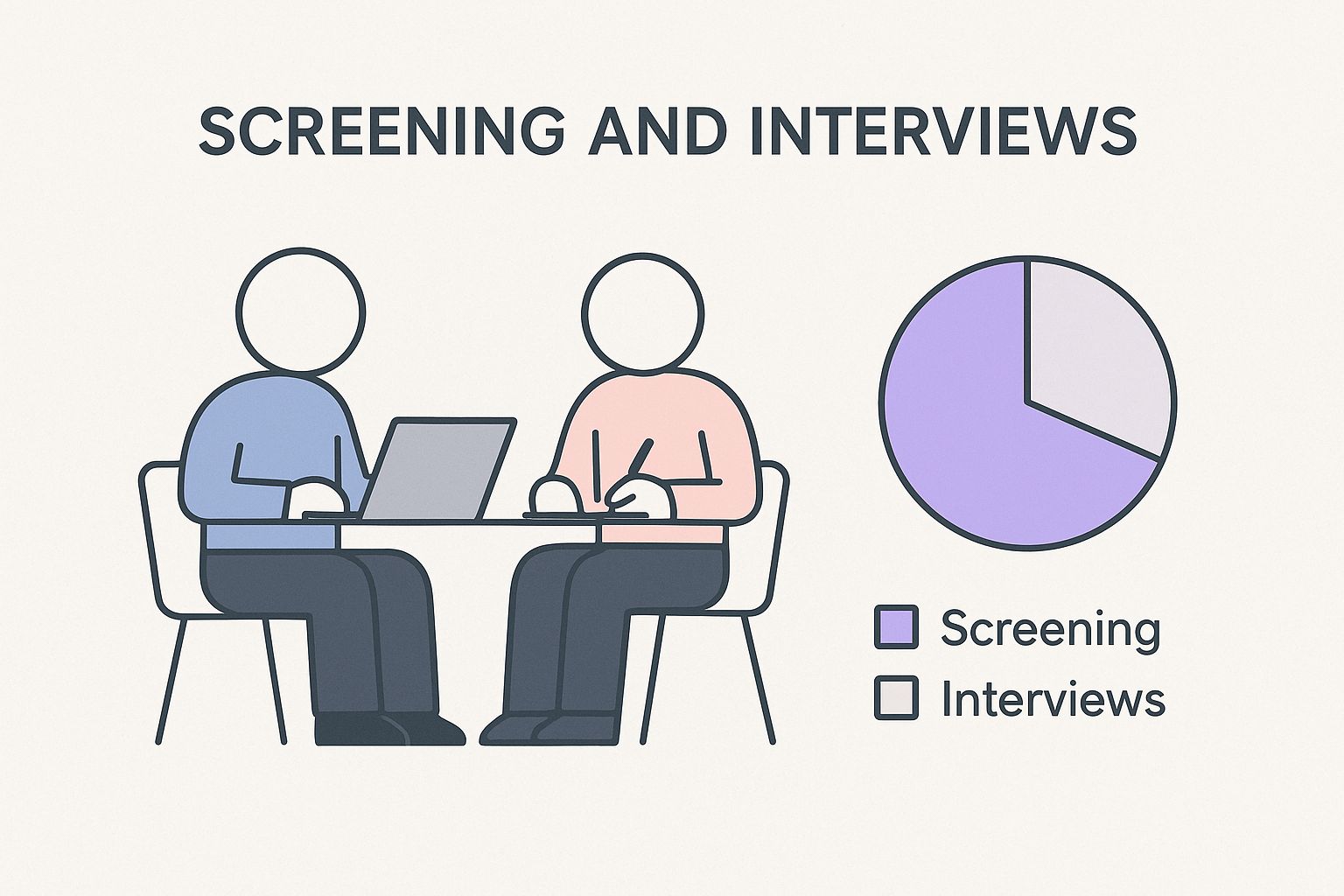
Let's be honest. If recruiting for engineers were easy, you wouldn't be here. You'd be shipping product. The hard truth is that the old playbook—post a job, wait for applicants, and pray for a fit—is fundamentally broken for technical talent. You need a smarter approach, one that respects both your time and the engineer's.
Turns out there’s more than one way to hire elite developers without mortgaging your office ping-pong table.

Does this sound familiar? You posted a job description written by a committee, waded through a hundred nearly identical resumes, and maybe even took a call with a recruiter who promised you a mythical "10x engineer" for a cool 30% fee.
The painful reality is that the tech talent market isn't just competitive; it's a completely different game. Hope you enjoy spending your afternoons fact-checking resumes and running technical interviews—because that’s now your full-time job.
It's not you, it's the market. Really. The global engineering talent pool is facing a massive supply-demand imbalance. Job openings for engineers are still sky-high, driven by insane growth in sectors like AI and data infrastructure.
The UK alone faces an annual shortage of up to 59,000 engineers. To put it bluntly: you’re fishing in a pond where the fish have all the power and your bait is a generic job description. Good luck with that.
A broken recruiting process doesn’t just slow down hiring; it puts a direct strain on your existing team, forcing them to carry the extra load while you search. This is a fast track to burnout and decreased output.
Understanding why your current system is failing is the first step toward implementing effective strategies to improve overall workplace efficiency and ensuring your team isn't left understaffed and overburdened.
We've been in the trenches, and we see the same self-sabotaging patterns over and over again. Founders and hiring managers often:
If your process feels like you're yelling into the void, it’s time for a change. You can't just post and pray anymore. You need to find fresh, creative recruiting ideas that meet engineers where they actually are.

Let's be brutally honest. Your job description is your opening pitch. It’s your first—and maybe only—chance to grab the attention of a talented engineer.
So why do most of them read like they were written by the legal department after a particularly dull Tuesday?
If your JD starts with a paragraph of corporate boilerplate before listing 15 "responsibilities," you’ve already lost. Top engineers aren't looking for a list of duties. They’re looking for interesting problems to solve, things to build, and a place where they can make a real impact.
Your best filter isn't a long list of requirements; it's the work itself. Instead of a generic title like "Senior Software Engineer," frame it around the mission.
Something like "Founding Engineer to Build Our Real-Time Analytics Pipeline" or "Full-Stack Engineer to Overhaul Our Legacy Checkout Flow" tells a candidate exactly what they’ll be walking into. It’s specific, it’s challenging, and it immediately sets you apart from the sea of corporate sameness.
Great engineers are driven by tough puzzles. Don't be afraid to be upfront about yours. A little honesty shows you respect their intelligence and aren't just selling a fantasy.
"A compelling job listing should outline the tools and languages the candidate should know, the projects the candidate will work on, and as much information about day-to-day expectations as is reasonable." – Karl L. Hughes, Engineering Leader
This isn’t about showcasing a perfect, problem-free environment. It’s about finding the right person who gets genuinely excited by your specific brand of chaos.
Scrap the old template. A job description that actually works is less of a wishlist and more of a conversation starter.
Here’s a better structure:
This reframes the entire dynamic. You’re not just recruiting for a role; you're inviting talented people to join you on a specific, compelling mission. It's the difference between getting another cold application and sparking a real conversation.
Let’s get one thing straight. The best engineers aren’t scrolling through job boards; they’re busy building interesting things. If your entire sourcing strategy leans on LinkedIn or Indeed, you're fishing in an overfished, underwhelming pond. I hope you enjoy celebrating those single-digit response rates.
To find great talent, you have to go where they are. This means leaving the comfortable confines of traditional recruiting platforms and venturing into the communities where engineers actually live. It requires a mindset shift—from poacher to participant.
Sourcing is just the first step. Once you find them, you need a solid process to screen and interview them. And that’s a whole other can of worms.

As you can see, finding the right people is only the beginning. The real work starts when you actually engage with them.
Not all sourcing channels are created equal. Some are flooded with noise; others offer a direct line to high-caliber talent. Here's our honest, battle-tested take.
| Channel | Potential Reach | Signal vs. Noise | Our Honest Take |
|---|---|---|---|
| Referrals | Low | Very High | Gold standard. Your best people know other great people. Always start here, but it’s not scalable on its own. |
| Niche Communities | Medium | High | Excellent. Engaging in language-specific Slacks, Discords, or subreddits builds real credibility. The long game pays off. |
| GitHub/Open Source | Medium | High | A fantastic signal. Seeing someone’s code is better than any resume. Requires real technical engagement, not just keyword searching. |
| Cold Outreach | High | Very Low | A numbers game with terrible odds. Most cold emails are ignored. Use it sparingly and only with hyper-personalization. |
| Job Boards | Very High | Extremely Low | The bottom of the barrel. You'll get tons of applicants, but the signal-to-noise ratio is abysmal. A necessary evil, maybe, but never your primary strategy. |
The takeaway is simple: prioritize channels with the highest signal. It's more work, but the quality of candidates is worlds apart from the slush pile you get from job boards.
The fastest way to get ignored is to show up in a community, spam your job link, and disappear. That’s not recruiting; it’s just digital litter. Your goal is to add value long before you ever ask for anything.
This isn’t about a quick win. It's about playing the long game and building a pipeline of passive candidates who might be interested next year, just because they respect you and your team.
Sometimes, you need to cut through the noise. A cold email asking for 30 minutes of a top engineer’s time is a huge ask with zero immediate value for them. It’s an easy "no."
So, change the equation.
Instead of asking for a free "coffee chat," offer a paid micro-project. A small, well-defined task that takes a few hours and pays a few hundred dollars can open doors that a thousand cold emails never will.
We call this The $500 Hello. It’s not just about the money; it's a powerful signal. It shows you respect their time, value their skills, and are serious about results—not just talk.
You get a real work sample, and they get paid to learn about your codebase. It’s the ultimate, low-risk "try before you buy" for both sides. Most companies are just too lazy to try it.
You’ve done the hard work of sourcing and now have a pile of candidates. Congratulations. Now what? You could spend your afternoons fact-checking resumes and running technical interviews—because that’s now your full-time job. Or, you could build a screening process that cuts through the noise with ruthless efficiency.
This isn't about finding a warm body to fill a seat. It's about finding someone who can actually do the work. And that means throwing out the old, broken rules.
Let's get one thing straight: the era of worshiping credentials is over. The entire landscape of recruiting for engineers is shifting away from traditional, degree-based hiring toward a much more pragmatic, skills-focused model. In 2025, smart employers are prioritizing proven technical abilities, because the rise of coding bootcamps and online learning has created a new class of exceptional talent without traditional pedigrees. You can find more insights on this shift by checking out 2025 engineering recruiting trends on Careerbee.io.
This means your screening process shouldn't be a credentials check. It should be a competency check.
Forget where they went to school or how many years of Python experience they claim to have. The only question you need to answer is: can this person solve problems and ship code? Everything else is just noise.
I’m not suggesting you let a robot hire your team. But using AI-driven tools as a first-pass filter is a massive sanity-saver. (Toot, toot! This is where we come in.) They can instantly weed out candidates who clearly don't meet the baseline technical bar, saving your team hours of wasted time.
These tools are not a replacement for human judgment, but a force multiplier for it. For a deeper dive, check out our guide on pre-employment skills testing, which breaks down how to integrate these checks effectively. We’re not saying we’re perfect. Just more accurate more often.
The single best screening tool is a small, real-world challenge. But for the love of all that is holy, do not ask them to whiteboard a binary tree reversal. It’s a useless, anxiety-inducing circus act that has almost zero correlation with day-to-day engineering. It only proves who is good at memorizing algorithms for interviews.
Instead, design a take-home challenge that mirrors a problem your team has actually faced.
This gives you a direct look at their code quality and problem-solving process—two things a resume will never show you. And to get a more rounded view, you might consider tools that can Enhance Team Dynamics with a Team Building Personality Assessment.
By focusing your screening on what actually matters—practical skills—you build a process that is not only more effective but also far more respectful of everyone’s time.
An interview shouldn't be an interrogation. For top engineers, it's a two-way street—they are evaluating you just as much as you are evaluating them. Mess this up, and the best candidates will politely ghost you while you’re left with a collection of gut feelings.
Your goal isn't to grill them. It's to have a series of structured conversations that reveal how they think, collaborate, and solve real problems. Forget the corporate script. It’s time to get real.
A good process has clear stages, each with a specific purpose. It’s not a gauntlet; it’s a progressively deeper conversation. Our process, refined through countless hires (and a few painful mis-hires), looks like this:
The Founder 'Vibe Check' (30 mins): My first call. I want to know if they’ve done their homework, if they’re genuinely interested in our problem, and if our communication styles click. It's a quick, high-level filter for initiative and mission alignment.
The Live Pairing Session (60-90 mins): We scrapped take-home tests. Too easy to over-engineer and they don't show collaboration. Instead, we do a live pairing session with a senior engineer on a small, real-world problem. It's not about getting the "right" answer; it's about seeing their thought process in action.
The Team Conversation (45 mins): The candidate meets two or three other people. This isn't another technical grilling; it's about seeing if they can hold a conversation with potential peers. Can they talk about past projects with clarity? Do they ask thoughtful questions?
You can tell everything you need to know about a company by the questions they ask. Generic questions get generic answers. Ditch "What's your biggest weakness?" for questions that uncover actual behavior.
The single most revealing question you can ask an engineer is: "Walk me through a technical decision you made that you now regret. What did you learn from it?" It tests for humility, ownership, and the ability to learn—three traits a million times more valuable than knowing some obscure algorithm.
Here are a few others we rely on:
These questions don't have a right or wrong answer. They open the door to a real conversation about experience and judgment, which is precisely what you’re hiring for when recruiting for engineers.
You’ve found ‘the one.’ Don't blow it now.
Making an offer is an art, and frankly, most companies are clumsy painters. This is your moment to turn a promising candidate into an enthusiastic new hire, not make them feel like they just survived a bare-knuckle negotiation.
The offer isn’t just a number; it’s the story of what it’s like to work with you. If you’re cagey, confusing, or cheap at this stage, you’re broadcasting exactly what the next few years will look like. Be transparent, direct, and human.
Let’s talk about equity. For most candidates, stock options feel more like a lottery ticket than real compensation. Don’t just throw a number at them.
You have to break it down. Explain the company's current valuation, the total shares outstanding, and what their grant actually means. A simple formula can turn a mythical number into something tangible:
(Your Company Valuation x Percentage of Equity Offered) / Number of Years to Vest = Annual Equity Value
It's not perfect, but it gives them a real number to anchor on.
The goal isn’t to win a bidding war. The goal is to make the candidate feel valued, seen, and genuinely excited to accept. The offer should be the logical, exciting conclusion to a great conversation.
This isn’t just about money, either. Reiterate the mission. Talk about the impact they’ll have. These are the tie-breakers that a higher salary elsewhere can't always beat.
The final stage of recruiting engineers is often a minefield. Demand is intense, and you’re not just competing on salary. For instance, chemical engineering employment is projected to grow 8% by 2032, a trend reflecting the broader demand across many engineering disciplines. This means you need a clear, respectful process for closing the deal. You can get more insights on the competitive landscape from ThePlanetGroup.com.
When you make the offer, pick up the phone. An email is transactional; a call is a sign of respect.
End the call by setting clear next steps and giving them a reasonable time to decide. 48-72 hours is fair. Anything more, and you’re just giving them time to shop your offer around.
We get it. You're in the trenches, and standard recruiting guides don't cover the messy reality of hiring engineers as a founder. Let's tackle the questions that keep you up at night with some brutally honest, no-fluff answers.
Stop thinking in percentages; start thinking in dollars.
Honestly, a candidate doesn't care about 0.1% equity. It’s an abstract number that feels like a lottery ticket. Instead, frame the grant in terms of its potential value.
Try this: "Based on our current valuation, this grant could be worth $X over your four-year vesting period." It's direct, transparent, and helps them connect their work to a tangible financial outcome.
It probably wasn't just one thing. Let's be real: top engineers are evaluating you.
Did your process drag on for weeks? Did you make them solve a pointless whiteboard problem? A slow, disrespectful process is a massive red flag. They have options. They didn't "ghost" you; they opted out of a bad experience.
Lead with transparency from day one. The best way to kill the awkwardness is to eliminate the need for haggling in the first place.
Post a clear salary range in your job description. When you extend an offer, present it as your best and final. This isn't a bazaar; you're building a partnership. If a candidate still pushes back, it’s a good opportunity to re-evaluate if your compensation is truly competitive.
This is also a perfect moment to make sure your entire process is equitable. For a deeper look, check out our guide on inclusive hiring practices that actually work.
